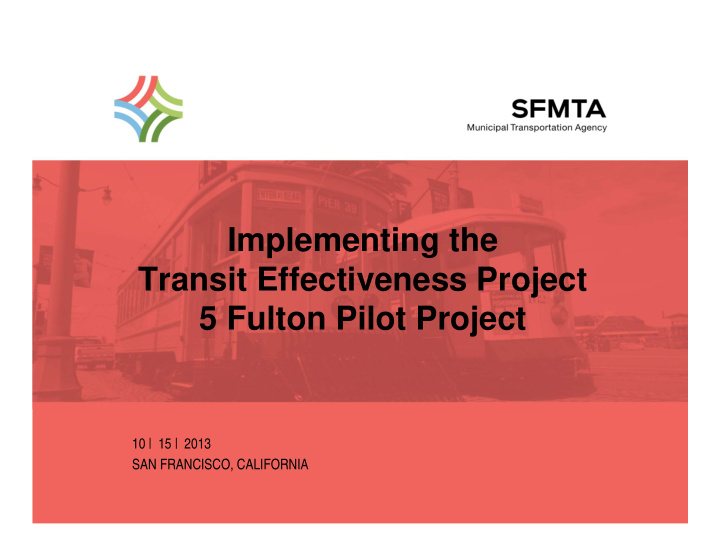



SFMTA Municipal Transportation Agency Image: Historic Car number 1 and 162 on Embarcadero Implementing the Transit Effectiveness Project 5 Fulton Pilot Project 10 | 15 | 2013 SAN FRANCISCO, CALIFORNIA
Transit Effectiveness Project • First comprehensive review of Muni in a generation, aims to transform Muni service to better meet customer needs • TEP objectives: – Improve service reliability – Reduce transit travel time – Improve customer experience – Deliver more efficient service • Recommendations based on unprecedented data analysis and extensive community outreach • Bond measure planned for November 2014 2
TEP Recommendations Improve Customer Experience • Establish a tiered service network to guide service delivery and capital investments • Restructure service and increase service hours up to 10 percent • Reduce travel time on key corridors by up to 20 percent 3
TEP CEQA Milestones • Initial Study published Jan 23, 2013 • DEIR Released July 10, 2013 (http://tepeir.sfplanning.org) • EIR Certification Anticipated Spring 2014 4
TEP Pilots: Building on Small Successes 76X Marin Headlands 5L Fulton Limited Express (planned) (ongoing) Church Street Red Carpet (ongoing) 5
5 Fulton Existing Overview • Daily ridership ~ 19,500 • Average speed ~ 9 mph (systemwide = 8.1 mph) • Average travel time ~ 50 minutes each way • 48 stops in each direction 6
5 Fulton Existing Performance • 2013 on-time performance similar to system average • 5 Fulton = 63% • System Average = 60% • Rapid Network = 60% • Approximately 20% of peak period, peak direction trips in September 2013 were over capacity • Approximately 10% of mid-day trips in September 2013 were over capacity 7
8 5 Fulton Existing Speed
5/5L Pilot Project Overview • New limited-stop service to reduce travel time • Increased frequency in the inner part of the route to reduce crowding • Low-cost capital improvements to further reduce travel time and improve safety • Mirrors TEP proposal, but without major investments such as bus bulbs, traffic signal changes, or overhead bypass wires 9
5/5L Pilot Project Outreach • SFMTA Citizens Advisory Committee and Multimodal Accessibility Advisory Committee July, 2013 • Held two public meetings (Richmond and Western Addition) in August, 2013 • Held public hearing September, 2013 • TEP list serve, web site, USF and neighborhood associations 10
11 5/5L Pilot Service Proposal (30% increase in service hours)
5/5L Pilot Benefits • Reduced crowding east of 6 th Avenue • 6% time savings for 5 Local • 10% time savings for 5L Limited – 15% savings between 6 th Avenue and Market Street • Improved transit and pedestrian safety with longer bus zones • Improved safety for all modes with road diet 12
5/5L Pilot Tradeoffs • Customers west of 6 th Avenue need to transfer to access local stops east of 6 th Avenue • ~9% of customers would need to walk to a different bus stop • Net parking removal ~20 spaces over 7 mile corridor 13
23 Bus Zone Extensions • Improves customer boarding experience when buses can pull to curb and reduces boarding time • Allows both 5 and 5L to arrive at limited stops at same time • Allows 5L to pass 5 at local stops 14
8 Bus Stop Optimizations • Reduces the number of times a bus must stop • Improves pedestrian safety at uncontrolled intersections 15
3 Right-Turn Pockets • Helps buses bypass congestion 16
Net Removal of 18 Bus Stops • Stop Spacing between La Playa and Arguello • Existing = 2.3 blocks (710’) • Proposed = 3 blocks (930’) • Stop Spacing between Arguello and Market • Existing = 1.5 blocks (720’) • Proposed = 2 blocks (960’) 17
18 Proposed Tow-Away on Central 7A-5P
Fulton Road Diet /Lane Widening • Redesign roadway between Baker and Stanyan • Provide traffic calming adjacent to USF • Address collision history for Muni and other modes • 70% of 51 Muni collisions in past 5 years were sideswipes Buses straddle narrow lanes 19
20 Fulton Road Diet/Lane Widening
Central Avenue/McAllister Street • Road Diet Adding app 20 spaces between Central and Baker • Removing 5 spaces on Central • Adding transit stop at Lyon 21
5/5L Pilot Next Steps • Implement bus stop, parking and traffic changes • Customer outreach • Operator training • Launch service changes • 6-month evaluation • 12-month evaluation 22
Recommend
More recommend